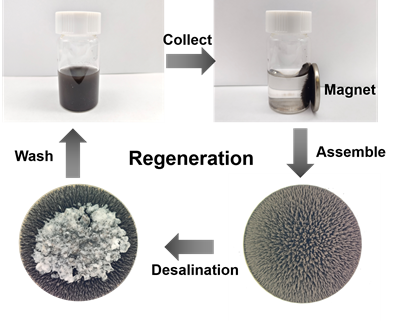Utilizing power from the sun is well known to be one of the keys to sustainable development but generating electrons from solar cells (photovoltaics) is not the only way to do it! Using solar energy to purify, or desalinate, seawater offers a sustainable alternative to energy-intensive reverse osmosis systems that are in large-scale use today. In theory, a photothermal membrane can use solar heat to power the purification of seawater, or other brine sources, by distillation. However, the solid minerals that are left behind tend to stop the membrane working after a short time and long-term, stable operation is a problem. One answer may lie in a recent paper published in the open access journal EcoMat, which aims to unite interdisciplinary research on functional materials for green energy and environments.
Dr. Hamdy Maamoun Abdel-Ghafar Hefny, from the Minerals Technology Division of WAITRO Member Central Metallurgical Research and Development Institute (CMRDI) in Egypt developed an extensive and long-term partnership that includes Prof. Dr. Heqing Jiang at the Qingdao Institute of Bioenergy and Bioprocessing Technology (QIBEBT) and Prof. Yuchao Wang at Dalian University in China. Their shared interests lie in utilizing solar energy for freshwater generation and other complimentary functions such as salt harvesting and green hydrogen generation.
Their recently published work focused on developing a dynamic photothermal layer that can be used both for freshwater production and salt harvesting. Magnetic nanomaterials such as Fe3O4 (magnetite) can be distributed across a membrane using induced magnetic fields to control the microstructure of the layer to form an array of fine needles with very high light absorption across the solar spectrum. Over time, however, the magnetite gets oxidized in the warm, humid environment to form Fe2O3 (ferric oxide, otherwise known as rust) which is non-magnetic and less light-absorbing. Coating the magnetic material with a carbon-based layer protected it from oxidation and further improved the absorption characteristics of the membrane, while allowing for the material to be regenerated under control of the magnetic field. The distillation residue contains minerals such as sodium and lithium, which themselves are important for the burgeoning clean energy storage industry.
The potential for clean production of drinking water while also enabling seawater to be mined for important minerals such as lithium by further processing the residues, potentially impacts both SDG6 and SDG7 and, no doubt, yet other SDGs in the areas of food security and health. Check out their paper, freely available online and contact Dr. Hamdy directly or via the WAITRO Secretariat if you are interested in partnering.

Regeneration of the desalination membrane to effectively mine seawater for useful minerals.
Details

Date: June 2023
Location: Egypt & China
Project Partners: CMRDI (Egypt) , QIBEBT (China), Dalian University (China)
- Collaborative Project
